Is "ICICI Prudential Regular Gold Savings Fund" merely following the bandwagon?
The global economic crisis instigated by the sub-prime mortgage lending in the U.S. has led to many investors taking refuge under the precious yellow metal. Prices of the precious yellow metal have shown a resilient up-move ever since 2008, and even today while the global economy is displaying an edgy economic recovery, many smart investors are preferring to take refuge under the precious yellow metal, thus safeguarding themselves against the backdrop of downbeat global economic events such as:
- Debt overhang situation in the Euro zone
- Downgrade of Greece’s sovereign rating from "Caa1" to "Ca" by Moody’s
- Downgrade of Italy’s sovereign rating from "A+/A-1+" to "A/A-1".
- Downgrade of U.S. sovereign rating from ‘AAA’ to ‘AA+’ with a negative outlook
- Accentuating inflationary pressures in the Emerging Market Economies (EMEs), including India
Taking advantage of these positive sentiments, the Indian mutual fund industry is witnessing the launch of several "gold funds" right since February 2011 (despite the skyrocketing prices of the precious yellow metal), thereby trying to woo investors. But herein let’s assess whether it is prudent to invest in the precious yellow metal at present.
Can gold get bolder?
Gold has been historically considered as an important asset class mainly for three reasons:
- It is a hedge against inflation
- It adds stability to the investment portfolio
- Asset Allocation avenue
And as an asset class, gold over the year has shown a secular uptrend. In 1971, the price of gold was about 32 U.S. dollar an ounce and today (mid-September 2011), gold has crossed U.S. dollar 1,800 an ounce mark. This indicates that price of gold has gone up by 56 times over the last 40 years. Even in the last 13 years (i.e. since Jan 2, 1998) as depicted in the chart hereunder, until August, 2011 gold prices have appreciated by whooping 533% (on an absolute basis).
Precious yellow metal shines!!
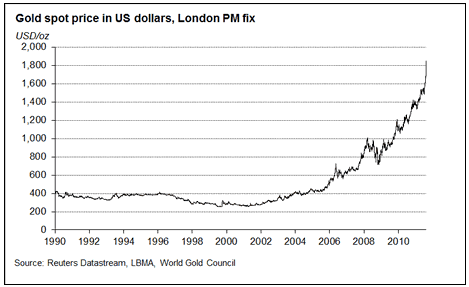
The House of Representatives have voted (on August 2, 2011) for an increase in the U.S. debt ceiling limit by U.S. $2.1 trillion (making it U.S $16.4 trillion), and also agreed to cut federal spending by U.S. $2.4 trillion dollars or more. But this seemingly would bloat their debt-to-GDP ratio thus making it daunting for them to manage because they are already paining with dismal quarter-on-quarter (Q-o-Q) GDP growth (in the last quarter i.e. April 2011 to June 2011, GDP growth rate was mere 1.00%) and high unemployment rate (9.1% in August 2011).
Big fat U.S. debt ceiling

(Source: whitehouse.gov)
At present in order to manage the fiscal deficit, President – Mr Barack Obama has laid out a U.S. $3 trillion dollar plan to cut the U.S. deficit by raising taxes on the rich. Justifying the move President Obama has also said "I will not support any plan that puts all the burden on closing our deficit on ordinary Americans. We are not going to have a one-sided deal that hurts the folks who are more vulnerable." However, investors want evidence that the Washington Political leaders are capable of tackling the towering U.S. fiscal deficit and country’s mounting debts. Moreover, if the U.S. Government fails to produce a credible plan for U.S.’s long-term debt, the concerns of rating agencies taking fresh actions also remain.
As far as the Euro zone is concerned, while Greece has pledged to bring forward painful austerity measures and has infused in some relief to the global markets, the qualms haven’t been relieved yet, as by next month it requires a humongous bailout package worth 8 billion Euros (or U.S. $11 billion). And the World Bank president – Mr Robert Zoellick has already warned that Europe can’t count on cash-rich emerging nations such as China and Brazil to come to Euro zone’s aid, and has also said that European leaders needed to take fundamental decisions about the currency union. Hence, the picture in Europe too narrates a gloomy story as the situation of debt overhang still prevails, thereby ascending the probability of a contagion spreading to Euro nations as well.
In India, while the Reserve Bank of India (RBI) has maintained its anti-inflationary stance and increased policy rates 12 times successively since March 2010; the results haven’t been too positive as the inflation bug continues to haunt and be over the comfort level (of 8%) of RBI (WPI inflation for August 2011 was 9.78%).
Thus taking a view of the aforementioned downbeat economic factors we are of the opinion that the northward trajectory for gold would be maintained as global economic recovery appears to be facing stumbling blocks. In fact being aware of the same, most economies led by the U.S. and the Euro zone ones are maintaining elevated levels of gold reserves too (as revealed by the chart below), in order to hedge the risk of an economic breakdown. Moreover if the U.S. dollar weakens due to bloated debt to GDP ratio, the northward trajectory would be clearly paved for the precious yellow metal.
Heaping up gold
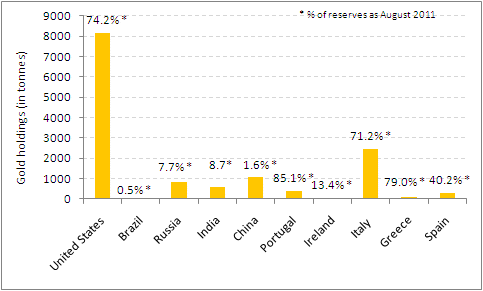
(Source: World Gold Council, PersonalFN Research)
Hence taking into account the fundamentals for gold presented above, we strongly believe that gold as an asset class makes a strong case for inclusion in one’s portfolio (as it would insure / hedge your portfolio against the various risks it is exposed to).
But let’s assess whether investing in gold through "ICICI Prudential Regular Gold Savings Fund" (IPRSGF) (a recent introduction to the product portfolio of ICICI Prudential Mutual Fund) would be a prudent investment decision.
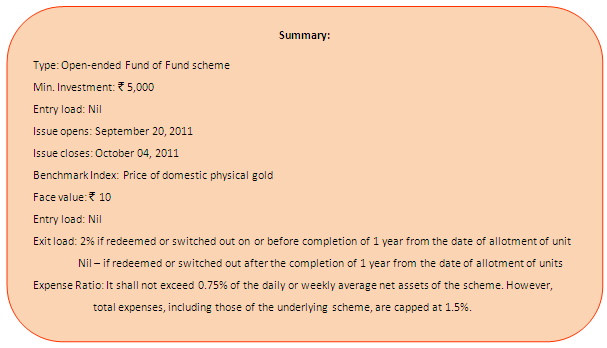
Positioning of the fund
It is important to note that IPRSGF is not a gold ETF (Exchange Traded Fund) but in fact a Gold Fund of Fund (GFoF) which will invest in the parent scheme of the fund house i.e. in ICICI Prudential Gold Exchange Traded Fund (IPGETF). As per its offer document, the investment objective of the scheme is "to generate returns by investing in units of ICICI Prudential Gold Exchange Traded Fund. However, there can be no assurance that the investment objectives of the Scheme will be realised.
The investments into underlying funds under the Scheme would, inter alia, be governed by:
- The investment management style of such scheme
- The tolerance and the risk profile of such schemes
- The asset allocation (such as equity or debt) of such schemes".
IPRSGF will in turn track the domestic prices of gold as IPGETF tracks the domestic gold prices.
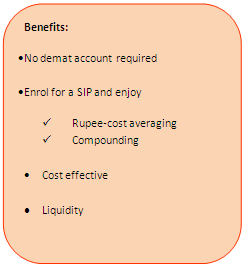
Thus being passively managed, IPRSGF enables its investors to invest in gold through a paper form, thereby providing the convenience of Systematic Investment Plan (SIP) as well as lump sum investments, but without having its investors to open a demat account to avail its benefits (
which is unlike Gold ETFs). Since SIP is a special feature of IPRSGF, it provides the convenience and advantage of rupee-cost averaging and compounding to its investors. Also since holding a demat account is not necessary, investors would not have to incur charges such as annual maintenance charge for demat account, delivery brokerage charges, transaction charges (while investing in demat mode) etc; thus making it a cost effective investment proposition.
Moreover liquidity too is not restrained by the fund, as investors can subscribe and redeem units on all business days directly from the AMC (
while purchase and sale of gold ETFs depends upon the liquidity on the exchange).
Portfolio & Investment Strategy
Portfolio of IPRSGF will predominantly constitute of investments in ICICI Prudential Gold Exchange Traded Fund (IPGETF), but not ruling out upto 5% allocation towards debt and money market instruments.
| Type of Instrument |
% of Net Asset |
Risk Profile |
| Units of ICICI Prudential Gold Exchange Traded Fund |
95 % - 100 % |
Low |
| Debt and Money Market Instruments (Including cash and cash equivalent and Liquid/debt funds) |
0 % - 5 % |
Low |
(Source: Scheme Information Document)
IPGETF too, which is the underlying fund, invests in physical gold; shall be of fineness (or purity) of 995 parts per 1000 (99.5%) or higher. Thus IPRSGF, being a feeder fund would be focused on providing returns that closely correspond to the returns provided by IPGETF.
Performance of the underlying fund – IPGETF
So far as revealed by the chart below, IPGETF has been closely tracking the price movement in physical gold before factoring in for the expenses.
The path so far
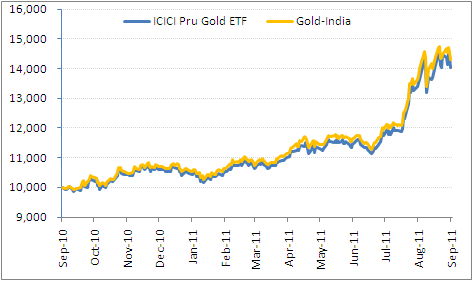
(Base:  10,000)
10,000)
Note: Gold prices are of MCX gold
(Source: ACE MF, PersonalFN Research)
How Gold ETFs have fared
| Gold Exchange Traded Funds |
Absolute |
CAGR |
Tracking Error |
Expense Ratio |
% Holding in Gold |
% Holding in Cash |
| 1 Month |
3 Months |
6 Months |
1 Year |
2 years |
3 Years |
| HDFC Gold ETF# |
3.0 |
22.2 |
30.8 |
40.7 |
- |
- |
0.0688 |
1.00 |
99.37 |
0.63 |
| ICICI Pru Gold ETF# |
2.9 |
22.2 |
30.7 |
40.3 |
- |
- |
0.0728 |
1.50 |
100.29 |
-0.29 |
| Kotak GOLD ETF** |
3.0 |
22.4 |
31.1 |
41.1 |
30.1 |
26.8 |
0.0694 |
1.00 |
100.02 |
-0.02 |
| GS Gold BeES* |
2.6 |
21.9 |
30.5 |
40.5 |
29.8 |
26.7 |
0.0688 |
1.00 |
99.98 |
0.02 |
| Reliance Gold ETF# |
3.0 |
22.4 |
31.0 |
41.2 |
30.1 |
26.4 |
0.0694 |
1.00 |
100.49 |
-0.49 |
| Religare Gold ETF** |
3.0 |
22.4 |
31.0 |
41.1 |
- |
- |
0.0693 |
1.00 |
100.33 |
-0.33 |
| Gold-India |
3.6 |
23.7 |
33.5 |
45.1 |
32.1 |
28.8 |
- |
- |
- |
- |
*Portfolio as on June 30, 2011
**Portfolio as on March 31, 2011
# For the rest of the schemes the portfolio is as on August 31, 2011 and the NAV data is as on September 17, 2011
(Source: ACE MF, PersonalFN Research)
When judged in comparison to its peers, the table above reveals that IPGETF having completed a 1-Yr period (incepted on August 24, 2010), is an underperformer in the category and has one of the highest tracking error.
Taxation
On the taxation front too as per the present tax laws (Income Tax Act, 1961), investment in IPRSGF would enable investors to avail the benefit of indexation on long-term capital gains after the period of one year of its holding. However, any sale of the fund before the period of 1 year would attract short-term capital gains tax.
It is noteworthy that at present for investment in physical gold, the benefit of long-term capital gains tax is available only after the completion of period 3 years of the asset’s holding.
Fund Manager Profile
IPRGSF will be managed by Mr. Chaitanya Pande who holds a Bachelor’s degree in Science and also has to his credit the PGDM from IMI, New Delhi. He has a total work experience of 15 years in Fund Management, and also manages the IPGETF along with other debt mutual fund schemes.
Fund Outlook
The launch of IPRGSF has come at the time when gold prices are near their all-time highs steered by following factors:
- Debt overhang situation in the Euro zone (due to failure of Greece and Italy to put their public finances in place)
- Edgy economic recovery in the U.S (Q-o-Q GDP growth rate at mere 1.00% in last quarter i.e. April 2011 to June 2011)
- Accentuating inflationary pressures in Emerging Market Economies (EMEs), including India
- Dwindling industrial growth in India (IIP at 3.3% in July 2011)
- Dwindling economic growth rate in India (7.7% GDP growth rate in Q1FY2011-12)
- Anti-graft campaign in India
- Piling up of inventory by stockists
Hence, while gold appear expensive to buy at these levels the aforementioned factors elevate the chances of it ascending further. Thus in order to hedge yourself against the risks we recommend that to periodically invest in gold by allotting 5%-10% of your assets and stay invested in it with a time horizon of 10 to 20 years.
However, one should be watchful about any long-term favourable news disseminating especially from the developed economies, as this may signal a corrective phase for the precious yellow metal. Since the IPRGSF would be investing in IPGETF (the underlying scheme) its fortune would be closely linked to underlying scheme’s performance.
Our View:
IPRGSF is benchmarked against the prices of physical gold in the domestic market. Considering the global uncertainties are persisting at present, we expect gold prices to remain firm and even ascend going forward. While IPRGSF offers the advantages of regular saving, rupee-cost averaging and power of compounding though the SIP route offered; its underlying fund – IPGETF has a performance track record of just one year (as against other gold savings fund which have a fairly long performance track record of its underlying gold ETF) which is a matter of concern. We believe that the IPRGSF is merely following the bandwagon of "gold savings funds", without permitting its underlying fund – IPGETF to complete a long track record. In fact, if we assess on 1-Yr return basis IPGETF’s performance has faltered marginally as against the category average.
Hence we recommend investor to give ICICI Prudential Regular Gold Savings Fund a miss, and instead invest in the other gold savings funds which have a longer performance track record of their underlying gold ETF scheme.
This article was written exclusively for Equitymaster, India's leading Independent research initiative. Trusted by over a million members all over the world, Equitymaster is known for its well-researched, unbiased and honest opinions on the Indian Stock Market.
Disclaimer: This note / article is for information purposes and Quantum Information Services Limited (PersonalFN) is not providing any professional / investment advice through it. The recommendation service, views, articles and other contents are provided on an "As Is" basis by PersonalFN. The facts mentioned in the note are believed to be true and from a public source. The Service should not be construed to be an advertisement for solicitation for buying or selling of any scheme / financial product. PersonalFN disclaims warrants of any kind, whether express or implied, as to any matter/content contained in this note, including without limitation the implied warranties of merchantability and fitness for a particular purpose. PersonalFN and its subsidiaries / affiliates / sponsors / trustee or their officers, employees, personnel, directors will not be responsible for any direct/indirect loss or liability incurred by the user as a consequence of his or any other person on his behalf taking any investment decisions based on the contents of this note. Use of this note is at the user's own risk. The user must make his own investment decisions based on his specific investment objective and financial position and using such independent advisors as he believes necessary. PersonalFN does not warrant completeness or accuracy of any information published in this note. All intellectual property rights emerging from this note are and shall remain with PersonalFN. This note is for your personal use and you shall not resell, copy, or redistribute this note, or use it for any commercial purpose. Please read the terms of use.
Add Comments
| Comments |
abadflor@info.com.ph
Nov 03, 2011
This forum needed shaking up and you've just done that. Great post! |
gdiincome123@gmail.com
Oct 08, 2011
Yes now gold is more stable than shares and stocks. At least the investor will get the amount he invested. The world stock market shows downward trend and the investors losing their hard earned money. Gold shows a steady increase. |
yseiuqw@hotmail.com
Sep 27, 2011
Different countries has its own way of earning depending upon the existing treasure and the needs of people. A country having the precious golden yellow metal is very lucky for having such element. Indeed, the sales out of this product contribute a lot to the country's economy. Some countries who are not benefited by natural resources, just focus on the modern communication services instead. Many phone service providers have decided to get rid of unlimited data programs entirely. The trend is in the direction of tiered programs that customize support to amounts of use. Some have balked, saying the tiered system will cost them more. But some specialists disagree, saying that limited programs are more economical. Regardless, there are several steps you can take to reduce cost with your data plan. Resource for this article: Saving money while surfing on your smartphone |
1